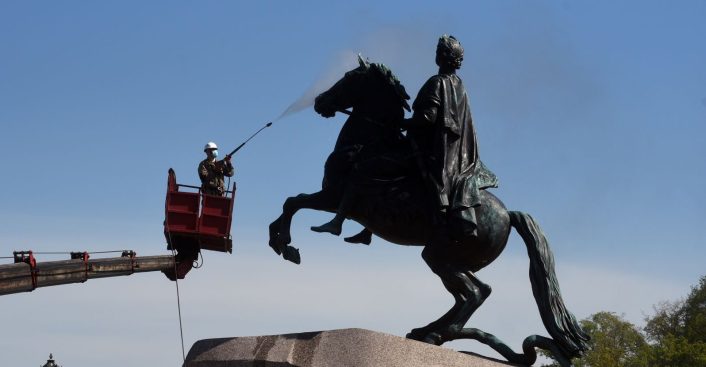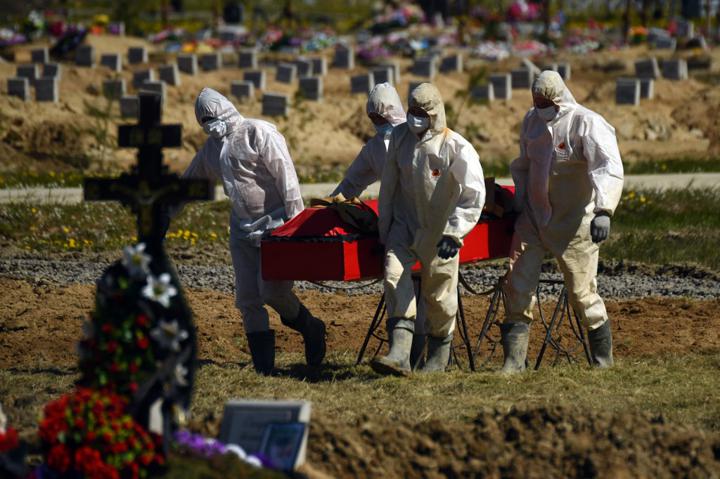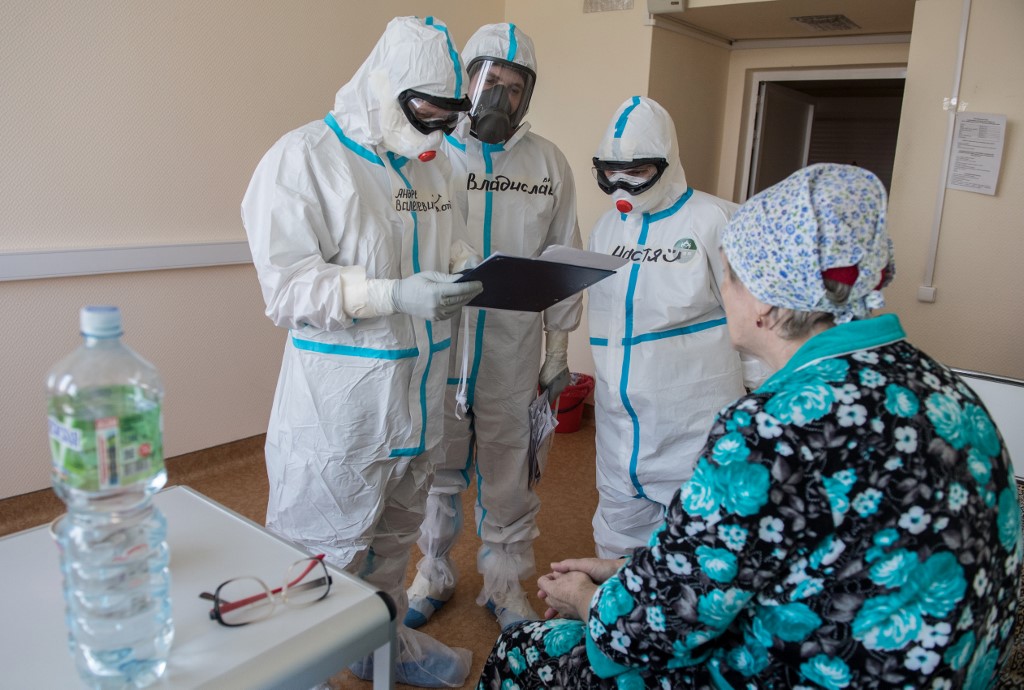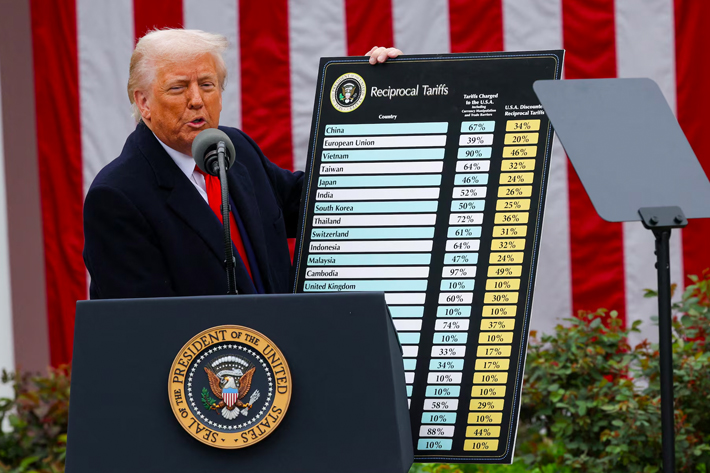In St Petersburg, Russia’s third coronavirus hotspot after Moscow city and the Moscow Region, self-isolation rules are only loosely enforced. City parks and streets are filled with people enjoying spring, which is warmly welcomed is this cold Baltic city.
“It’s difficult to wear a mask when it’s so warm in the street – people need to breathe,” says Aisha, 23, who works in a pharmacy on the outskirts of the city. “But it’s not that bad as high temperatures reduce the virus’s spread.”
“I feel the epidemiological dynamic in Russia is quite good. As a megalopolis, Saint Petersburg is doing pretty well,” she added.
Aisha’s relaxed attitude is partly due to the low number of coronavirus casualties locally – 150, a relatively low number for a city with a population of over 5 million.
Her mother Lyudmila, 50, is not too worried about the virus either; she is much more concerned about the economic situation. Her son, who works in the service industry, lost his job due to the lockdown. “I really hope this will end soon. We were hit very hard economically.”
As the coronavirus outbreak in Russia finally peaked in mid-May, the country started to slowly loosen quarantine restrictions. Even so, the virus has now spread right across the world’s biggest country, to the point that Russian infections have now re-infected China.
Moreover, with the country’s GDP dropping by 28% in April due to lockdown measures, President Vladimir Putin’s approval rates are down: according to the independent pollster Levada Center, 59% of Russians currently favour Putin – a record low for him.
Putin’s big plans for 2020, which included a nationwide referendum to alter the constitution, thereby granting him a reelection opportunity in 2024, and a glorious military parade for the 75th anniversary of the victory over Nazi Germany, have both been postponed due to the pandemic.
However, it is the nation’s real number of Covid dead that is raising questions – which are even being asked in mainstream media outlets that are usually highly supportive of the president.

In the city he founded, St Petersburg, the statue of Peter the Great is cleaned by a masked public worker. Photo: AFP
High infections, low deaths
Despite boasting the world’s third-highest number of Covid-19 infections after Brazil and the US, Russia has suffered a remarkably low death toll. The case mortality rate of those infected is only 1%, a staggeringly low figure if compared to the other countries hit hardest by the virus. The UK’s mortality rate is 14% and Spain’s is 12%.
At least, that is what the official statistics say.
In a video call with Putin, Anna Popova, the head of Russia’s sanitary watchdog Rospotrebnadzor, boasted that Russia’s low mortality rate was proof of the country’s effective response, which allowed the government to “buy time and prevent an explosive growth of the infection.”
On the other hand, critics say Russia’s creaky healthcare system, especially in the country’s vast provinces, is incapable of keeping mortality rates so low.
Russia’s low mortality rate can be largely explained by the classification method adopted in the country. Unlike most Western countries with higher death tolls, where official statistics include everyone who died after testing positive for Covid-19, Russian official data only take into account cases where Covid-19 was the primary cause of death.
For instance, according to the official statistics in the Ural region of Chelyabinsk, 13 people officially died of coronavirus – but 18 more had tested positive before dying. The latter were not included in the Russian overall death toll as Covid-19 was not considered the primary cause.
“We can’t put everything down to the coronavirus,” the Health Ministry’s head pathologist Georgiy Frank told the Ekho Moskvy radio station. “The numbers have to be objective. Covid is often the cause, but not always.”
Widespread scepticism
Russia’s count method drew widespread scepticism, as critics say it leaves space for possible manipulation by local authorities eager to please the Kremlin with positive results.
According to an investigation published by the The New York Times and the Financial Times, the real number of deaths in Russia could be 70% higher than official figures show. The outlets’ conclusion is based on the all-cause mortality rate in Moscow and Saint Petersburg, which during the month of April registered over 2,000 more deaths than the same period in the past years. Official Covid-19 deaths for the same period amounted to only 629 in the two cities.
Russian authorities categorically rejected the allegations, with Foreign Ministry spokesperson Maria Zakharova defining them as “fake news stories.”
The World Health Organisation’s representative in Russia, Melita Vujnovic, took the side of Russian authorities, stating that Russia’s methodology is “in line with world-best practices and with the recommendation of the WHO,” and that there is no proof of manipulation.

Cemetery workers in chemical protective suits carry a coffin at the funeral of Covid-19 victims in Kolpino, outside St. Petersburg on May 23, 2020. Photo: Sergey Nikolaev/ NurPhoto, AFP.
40 doctors dead in Dagestan
Still, some numbers remain difficult to explain. For instance, a disproportionately high number of deaths among Russian medical doctors which, according to local media outlet Mediazona, is around 16 times higher than it is in countries with similar infection rates.
The outlet’s conclusion is largely based on information found on List of Memory, a website created by a group of Russian doctors as a tribute to their colleagues who died with symptoms of Covid-19.
As reported by the outlet, this discrepancy might indicate a catastrophic shortage of protective gear for medical workers or inaccurate official statistics, or both.
The discrepancy between reality and the official statistics became impossible to ignore in the Muslim region of Dagestan, southern Russia, which recently became a major epicentre of the virus outbreak.
The local healthcare system has been overwhelmed by the pandemic. Hospitals are overcrowded, testing is inadequate and there is a shortage of protective equipment.
As the crisis unfolded, local authorities were forced to admit that official statistics underestimated the real number of deaths, many of which had been registered as pneumonia deaths.
Dagestan’s health minister admitted in an interview that over 40 local doctors had died since the start of the pandemic. The interview gained huge resonance, given that at the time of the interview, there were only 27 deaths from the novel coronavirus officially registered in the region.
That news made its way even into Russia’s mainstream media, which is usually supportive of officials.
“In Dagestan, 40 doctors died of the coronavirus – 40 DOCTORS,” wrote Margarita Simonyan, editor-in-chief of Kremlin-backed RT. “I really don’t want to believe that this is true.”
As local authorities told Putin in a video call, the real numbers could be even higher. “No one is collecting statistics on people who are dying from the disease in their own homes,” the mufti of Dagestan, Akhmad-Khadzhi Abdulayev, said. “They die, they are buried according to customs, and no one counts them.”
Putin promised to send aid to Dagestan and ordered the Defence Ministry to set up a 1,600-bed mobile hospital in the region.
West to East
On May 11, Putin terminated the “non-working days” period, which halted all non-essential business activities in Russia for over two months.
But with the president taking a back seat since the crisis started, regional leaders have been largely responsible for containing the pandemic.
In the Russian Far East, quarantine restrictions are being lifted despite the region’s delicate status as a gateway to China, as well as Japan and South Korea. Its geography makes it particularly vulnerable to virus outbreaks.
As the pandemic was mounting across Russia, Primorsky Krai was used as a transit zone by Chinese nationals traveling home from Western Russia via Vladivostok.
Apparently, at a time when Russia’s infection rate was spiking, many Chinese nationals sought refuge in their home country, where the pandemic had been largely tamed.
That made Russia the largest exporter of new coronavirus cases to China, with hundreds of new cases detected in the Chinese border town of Suifenhe. Most were Chinese domiciled in Russia who had recently traveled back to China through the main land crossing Pogranichny.
In order to prevent a second wave of infections, Chinese authorities put Suifenhe in quarantine and shut the border with Primorsky Krai in April, leaving many Chinese nationals stranded on the Russian side.
Governor of Primorsky Krai Oleg Kozhemyako expressed concern that Chinese citizens in transit might be responsible for an increase in the number of infections in the region.
This story appeared first in Asia Times
























